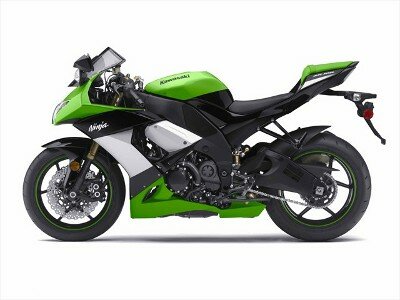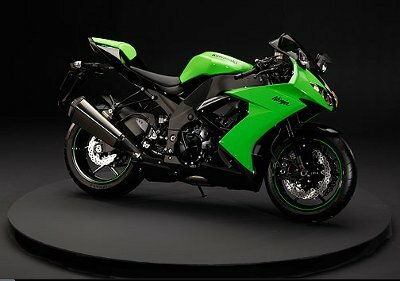Kawasaki Ninja Series
This article is related to Kawasaki
Kawasaki Ninja ZX10R
Ninja ZX10R History
The Kawasaki Ninja ZX10R was officially introduced in 2004, with its first minor revisions in 2005, with a complete overhaul to the Ninja ZX-10R in 2006 and its last was mid 2008. The Kawasaki Ninja ZX10R combines ultra-narrow chassis, low weight, radial brakes, and strong engine make it a very competitive package for its Japanese rival, on the Thai market, the Yamaha YZF-R1.
Engine
The Kawasaki Ninja ZX10R is powered by a very compact, narrow and lightweight designed, four-stroke, liquid-cooling, DOHC, four valves per cylinder, inline-four, 998cc displacement engine. The one-piece upper crankcase and cylinder casting saves weight and offers increased rigidity, oil is routed through channels milled into the cases on various parts of the engine, eliminating oil lines and saving weight.
The four cylinders have a 76.0mm bore and 55mm stroke. Kawasaki uses for the ZX10R a high compression ratio of 12.9:1. The fuel injection is by DFI with four 43mm Keihin throttle bodies with oval sub-throttles, two injectors per cylinder. The ignition is done by TCBI with digital advance and Kawasaki Ignition Management System (KIMS).
The stacked triangular layout of crank axis, input shaft and output shaft reduces engine length and lowers the center of gravity, and the lightweight crankshaft maintains the same inertial moment as heavier design but saves almost a kilogram. Kawasaki uses a low friction oil pump for the new 2008 model.
On the engine cooling the water pump uses the same type impeller as the ZX-14 with pump rpm optimized for less friction, with a lightweight Denso radiator with tightly packed cores and specially designed internal fins on the liquid-cooled, aluminum oil cooler for high-efficiency heat dissipation.
The four cylinders have a 76.0mm bore and 55mm stroke. Kawasaki uses for the ZX10R a high compression ratio of 12.9:1. With special designed Intake ports, exhaust ports and combustion chambers designed for optimum flow efficiency and top-end power. The fuel injection is by DFI with four 43mm Keihin throttle bodies with oval sub-throttles, two injectors per cylinder. The ignition is done by TCBI with digital advance and Kawasaki Ignition Management System (KIMS). 
Kawasaki Ignition Management System
The Kawasaki Ignition Management System, or KIMS for short, helps curtail sudden spikes in engine speed, enhancing the rider’s control of power delivery. It's designed not to interfere with the rider’s inputs, the complex ECU program remains passive, unless the change in engine speed exceeds the predicted response for the given parameters, the KIMS will not engage.
The KIMS Monitors engine speed, throttle position, vehicle speed, gear position, FI input data (feedback from intake air temperature, intake air pressure, engine temperature and O2 sensors), and rate of RPM change, then adjusts ignition timing to help regulate power delivery. IT is only possible to adjust the KIMS parameters with an accessory racing (circuit-use only of course) kit installed.
RAM Air Intake
The Ram air intake duct shaped for lower intake noise and higher intake efficiency. The larger airbox offers accessibility and ease of maintenance
Exhaust System
The Ninja ZX10R features a pre-chamber under the engine to reduce exhaust noise, and minimize silencer volume. A Palladium catalyzer helps the ZX-10R to meet strict Euro-III exhaust emissions standards needed for Thailand. The single orthogonal, titanium silencer, along with the pre-chamber, lowers the bike’s center of gravity and improves exhaust efficiency.
Transmission
The six-speed transmission gear ratios suit the power characteristics for ideal power delivery in the low and high-rpm ranges. Final reduction ratio of 17/41 intensifies the acceleration, while it features an adjustable back-torque limiting clutch.
Chassis and Suspension
Chassis
The unique twin-spar frame features an optimized stiffness balance through a mixture of materials, shapes and thicknesses, which alleviate critical stress concentrations, and the ribbing on the interior of the pivot plate where it joins the frame’s upper cross member slightly slows down the frame feedback for a more accurate feel. A swingarm pivot located to aid with the front-rear weight balance.
A lightweight, two-piece, aluminum die-cast sub-frame is mounted to the frame’s upper cross member, so rear suspension feedback is transmitted more directly to the rider. The narrow sub-frame layout contributes to the compact and slim rear of the bike
Suspension
The Kawasaki Ninja ZX10R uses DLC (Diamond Like Carbon) fork tube coating on the fully adjustable 43mm inverted fork improves fork action with less friction, smoother action and better road holding. The bottom mounted springs completely submerged in oil for reduced frothing and improved damping performance, fork action and road-following ability. The fully adjustable shock features dual (low-speed and high-speed) compression damping, providing the fine-tuning needed for racing.
Performance
The Kawasaki Ninja ZX10R can produce 138,3 kW (188 PS) @ 12.500rpm, and 147,1 kW (200 PS) @ 12.500rpm with the use of the RAM Air. The maximum torque is 113 N·m (11,5 kgf·m) @ 8.700rpm.
